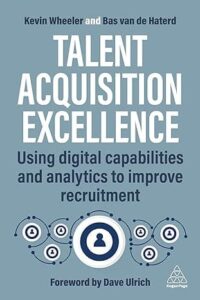The talent acquisition field has consistently been an early adopter of HR tech, using it “not as a crutch but as a catalyst,” according to Mercer researchers. The consulting firm also found that most HR departments use two or more platforms to facilitate the recruiting process. Meanwhile, new AI-driven solutions are hitting the market at a steady pace. The authors of a highly anticipated book geared toward recruiters and talent acquisition specialists sat down with HRE to discuss how HR leaders can capitalize on technology and digital capabilities for enterprise recruitment efforts.
Talent Acquisition Excellence: Using Digital Capabilities and Analytics to Improve Recruitment (KoganPage) is co-authored by Kevin Wheeler—a seasoned HR, talent acquisition and L&D consultant from Fremont, Calif.—and Bas van de Haterd, a respected speaker and consultant from Soest, the Netherlands.
Throughout the chapters, practical examples and case studies from organizations across the globe provide real-world context. “We believe the general themes in TA are global, but the way they influence your regional or local TA strategy might differ per country,” says van de Haterd. Because of this, the duo has written on global recruiting themes and, where possible, offered localized examples of how they would affect a company in certain jurisdictions.
The book guides readers through common recruitment activities, including how artificial intelligence, algorithms, automation and machine learning can improve them. It also delves into ways broader aspects of the economic landscape have impacted the recruiting practice.
Tech gains in the TA field
According to research from Mercer, TA is taking the lead in early HR tech adoption. A study performed by St. John’s University of New York and Mercer shows virtual recruitment has shifted to the mainstream.
The report surveyed 477 TA and HR leaders from a variety of backgrounds. It found that more than 80% of respondents use technology for screening, and more than half use technology for interviewing and candidate evaluation.
When it comes to AI specifically, nearly 40% engage it to build their talent pipelines—the most common application of AI in the talent acquisition function.

There are reasons why technology has such a strong place in the TA practice. “Without analytics, all decisions are subjective and potentially biased,” Wheeler told HRE. “Analytics help reduce bias, predict success and make decision-making easier and faster.”
Van de Haterd put it this way: “Without analytics, you’re just guessing, and guessing gave us 50% mis-hires. Guessing gave us massive labor market discrimination. Guessing gave us million-dollar budgets for advertising.”
The power of analytics for TA
The authors describe how analytics drive informed decision-making around talent acquisition. Van de Haterd says there are two ways to consider the value of analytics in TA. One is defining and identifying the true qualities that matter and match with open roles.

Analytics are central to deeply understanding the location of potential candidates, their interests and how best to engage them, according to Wheeler. “The skills of successful past hires help improve the quality of future hires,” he says.
The other is to determine what type of message resonates best with the target candidate audience, per persona for each job. Van de Haterd references a case study of hiring security guards at Schiphol Airport in Amsterdam.
“They managed to hire people they couldn’t find before at a fraction of the cost of what they used to hire for by adjusting the messaging to different [personas].”
Skills needed for the AI age
The authors cover the three main skills that are most valuable to an organization in the age of AI. He points out that HR leaders should look for these talents in new hires, particularly these previously undervalued qualities:
- The editor: (S)he who checks the AI and improves the outcomes (not just textually; editing should be taken in its entire spectrum). Currently seen as “annoying people who always see room for improvement.”
- The core researcher: The person who wants to know the core of the data, the training model and the exact algorithm. Currently viewed as “people who are never satisfied with the PowerPoint presentation but want the scientific journals that it’s based on.”
- The true creative: Think the Gaudi or the Picasso. Currently seen as “oddballs or weirdos who don’t simply think outside the box, but don’t even see a box to begin with.”

Van de Haterd says that, to synthesize the creatives, an organization also needs people who can translate messages from the true creatives for the rest of the organization. “I’m not saying dumbing it down, but using vocabulary that the rest can understand,” he says.
The book also outlines crucial skills for recruiters to future-proof themselves in a digitalized recruitment environment. These include knowledge of analytics; networking, marketing and influencing; technical acumen; ability to build relationships and teams; and agility. The most important, he says, is data literacy.
“You don’t have to be a data analyst,” van de Haterd says. “But you need to be able to understand data, ask questions about data, and sometimes torture data until it gives you its secrets.”
What AI can (and can’t) do for TA
AI is changing talent acquisition, according to van de Haterd. “It’s already better at many things than average people are,” he says. “It’s better in selection than your average recruiter; it writes better outreach messages than your average sourcer; it finds more and better people than the average recruiter.”
Here, he’s talking about average workers, noting that AI hasn’t yet reached the level of exceptionally skilled employees and it probably never will; however, emerging tech is already able to replace a lot of tasks people are doing now.
The book asks the reader to consider whether HR will alter recruitment methods to harness AI’s capability or try to repair a broken process by throwing more technology on top of it. “Our book gives several examples of talent strategies—not just talent acquisition strategies—that organizations can implement to fully harness the power of AI combined with the power of humans,” says van de Haterd.
Most of all, he says, TA professionals should learn how to analyze data: “See what it really tells you.” Gathering data—something the human resource profession has done for ages—is something AI can do much better. But interpreting data, says van de Haterd, that’s where the human comes in.

